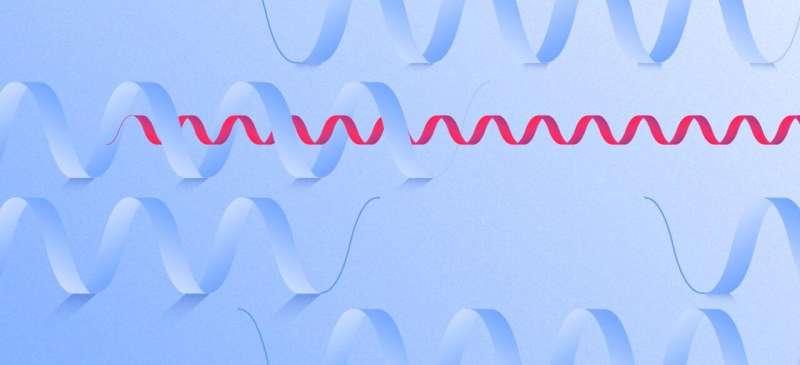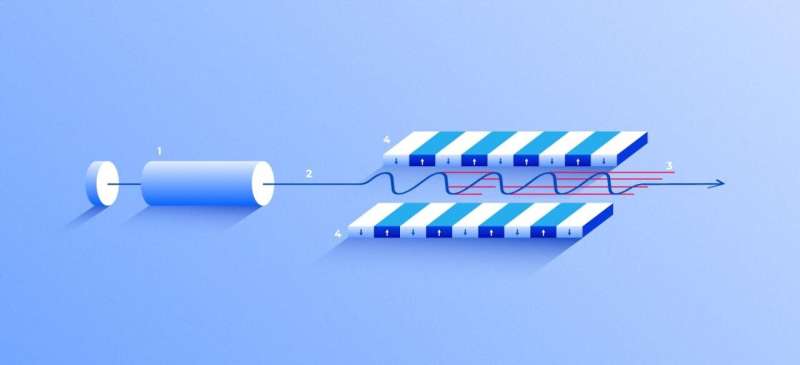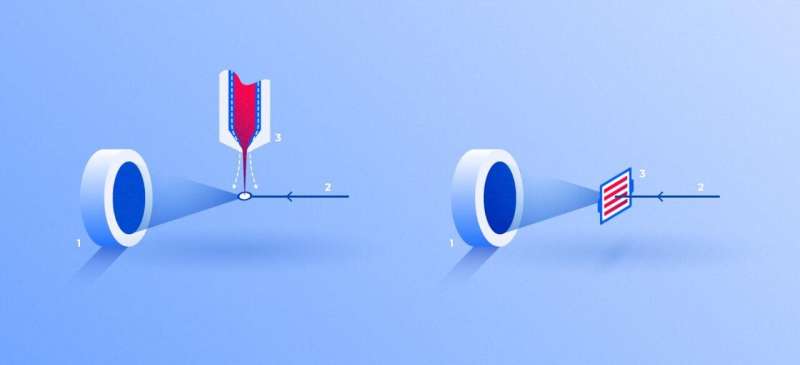X-ray laser sight reveals drug targets

Researchers from the Moscow Institute of Physics and Technology have published a review on serial femtosecond crystallography, one of the most promising methods for analyzing the tertiary structure of proteins. This technique has rapidly evolved over the past decade, opening new prospects for the rational design of drugs targeting proteins previously inaccessible to structural analysis. The article came out in the journal Expert Opinion on Drug Discovery.
X-ray crystallography
X-ray crystallography is one of the main methods for revealing the 3-D structure of biological macromolecules, such as proteins. It has helped determine the structure of numerous pharmacologically important enzymes and receptors, enabling the design of drugs targeting these proteins.
The method involves crystallizing a protein and studying it via X-ray diffraction. First the protein is isolated and purified. Then the solvent gradually dries out. As a result, the molecules whose structure is being investigated form crystals, characterized by an internal order. By exposing a crystal to X-rays in a special device, researchers obtain a diffraction pattern. It contains information on the positions of atoms in the crystal. A close analysis of the pattern reveals the 3-D structure of the constituent protein molecules.
Before the advent of this method, new drugs were mostly sought empirically: either by changing the structure of the molecules known to affect the target protein, or by sorting through arrays of molecules in chemical libraries. Now that the 3-D structures of many target proteins are available, researchers can view them on a computer screen and quickly sort through millions of compounds searching for drug candidates. That way they save much time and money previously spent on chemical synthesis and "wet" experiments.

X-ray crystallography produces good results for crystals that are large, stable, and homogeneous—that is, with no impurities or structural defects. To better detect a weak diffraction signal, a powerful radiation pulse is needed, but not so powerful as to destroy the crystal. In conventional X-ray crystallography, a protein crystal is rotated in the X-ray beam to produce diffraction patterns for various spatial orientations. This captures maximum information on the structure.
Method for tricky targets
Soon after X-ray crystallography emerged, it became clear that not all biological macromolecules can be crystallized. Some proteins are ordinarily dissolved in the inner cell medium. So it is fairly easy to put them into solution, evaporate it, and obtain a large regular crystal. But membrane proteins, many receptors among them, form crystals that are not large and pure enough for standard X-ray crystallography. That said, many of these proteins are involved in disease development, meaning their structure is of great interest to pharmacologists.
Less than a decade ago, a solution was found for membrane proteins. This new technique, called serial femtosecond X-ray crystallography, or SFX, relies on X-ray free-electron lasers, developed shortly before SFX.
Alexey Mishin, deputy head of the Laboratory for Structural Biology of Receptors at MIPT, who co-authored the study, explained: "What makes it a breakthrough technology is a very high energy density of the laser pulse. The object is exposed to such powerful radiation that it falls apart, inevitably and almost instantly. But before it does, some individual quanta of the laser pulse scatter off the sample and end up at the detector. This is the so-called diffraction-before-destruction principle for studying the structure of the original protein."

X-ray free-electron lasers proved useful outside biology: Over the past years, SFX has been used increasingly often by physicists and chemists, too. The first device became available to experimenters in 2009, and now there are five centers open to researchers in the U.S., Japan, South Korea, Germany, and Switzerland. A new one is being built in China, and the U.S. facility—historically the first one—has announced plans for modernization.
While the new technology has offered researchers a glimpse into the structure of proteins previously eluding analysis, it has also promoted novel technical and mathematical solutions. Conventional X-ray crystallography involves exposing one crystal to radiation from various angles and analyzing the resulting diffraction patterns collectively. In SFX, the crystal is instantly destroyed by the first interaction with a powerful X-ray pulse. So researchers need to repeat the process with many small crystals and analyze the "serial" data thus generated, hence the name of the method.
A further challenge is selecting the samples for SFX. In conventional X-ray crystallography, simply choosing the largest and highest-quality crystal was the way to go. This could be done manually, by eyeing the available samples. The new procedure requires working with a suspension of many small crystals of varying size and quality. Centrifuges and filters with known pore dimensions are used to separate the crystals by size.
Methods for placing samples into the chamber had to be elaborated, too. X-ray free-electron lasers have a certain maximum frequency at which they can emit radiation pulses. To reduce the expenses and time consumption, new crystals should be fed into the chamber at the same frequency. So far, two approaches have been developed for doing this. Under the first one, the crystals enter the chamber in a liquid suspension, supplied by an injector. The jet leaving the injector is "squeezed" by a stream of gas to ensure correct sample placement. That is, when passing through, a crystal ends up precisely at the center of the laser beam (fig. 2, left). Alternatively, the protein crystals can be spread over a substrate transparent to X-rays and automatically fed into the laser beam before each pulse (fig. 2, right).
Since producing its first results in 2011, SFX has revealed over 200 protein structures. Among them are 51 targets potentially important for pharmacology—membrane receptors, ferments, viral proteins, etc—that were formerly inaccessible to conventional analytical techniques.
The systematic review of the technology as applied to biology and pharmacology by the MIPT team will no doubt aid other researchers seeking to obtain the structures of key drug targets to develop new medications.
More information: Alexey Mishin et al, An outlook on using serial femtosecond crystallography in drug discovery, Expert Opinion on Drug Discovery (2019). DOI: 10.1080/17460441.2019.1626822
Provided by Moscow Institute of Physics and Technology



















